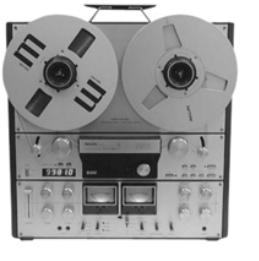Philips N-4520 User Manual

1978 Philips N4520
Philips N4520
Test Report (Best Buy Magazine, circa 1978)
Much was rumoured about this machine before its eventual appearance, and the review sample supplied was the quarter-track stereo model, a half-track one being available shortly. Three tape speeds of 9.5, 19 and 38cm/s are incorporated, and reels of up to NAB size can be used on the entirely logic operated transport. Variable spooling speed and cueing are provided, and the deck functions will transfer neatly from any mode to any other. Intended for vertical or horizontal operation, phono line in/out and 5-pin DIN sockets are mounted at the bottom of the deck panel, whilst ¼ in jacks are fitted on the front for mike (left channel stereo, right mono) and headphones (balance and separate gain allowing ample volume and clipping margin for all types). Pre-set replay gain and record current setting are fitted, and a multi-pin DIN socket allows special testing and operating. The mains lead is 2-core, and unfortunately no earth terminal is fitted. A stereo ganged master fader is mounted
vertically, whilst the ganged rotaries for mike/DIN and line inputs each with an additional balance control were liked.
Two large VU meters can be switched to normal VU or peak reading characteristics and in each position transients were surprisingly accurately indicated, although some HF boost was applied to the meter, which is irritating. LEDs are also fitted, operating at +7dB and -10dB, and deck lever switches operate input selection sources /tape monitoring (an auto position fulfilling DIN monitoring convention), 38cm/s DIN/NAB overall equalisation (splendid), tape speed, sound on sound, and stereo/mono track selection. Whilst bias is internally preset for the three speeds, a centre idented ganged rotary allows this to be adjusted up and down for using other than recommended tape types, which is most useful. The five figure indicating tape counter shows length in meters to the nearest decimetre, and whilst this worked well, hours and minutes would have been better. Excellent NAB adaptors are supplied.
Full speed spooling was untidy, but at reduced speed it was excellent (2m.40s at fastest). The basic transport is very similar to that of the Revox 700, and was superb, with auto tensioning giving very low phase jitter and wow, and excellent stability throughout. The speeds were also surprisingly accurate, being only 0.25 fast throughout.
All input circuits were as well designed as I have even known with amazing sensitivity, extraordinarily good clipping margins and low noise, including the microphone inputs which allow moving coil as well as capacitor types to be used. Philips circuitry here, including mixing, should be a lesson to every other manufacturer, for distortion is also at a minimum.
Replay responses of the original prototypes were a little uneven, but after Philips had corrected them, they were slightly and equally down at 15kHz at all speeds, but this was not really a problem. Replay hum and noise measurements were extremely good throughout, overall azimuths were very well optimised throughout, and clipping margins were very good, although the very highest level stereo masters might show marginal clipping very occasionally.
file:///P|/9105%20werkdirectorie/Manufacturers,%20Manuals/Tapedeck/tests/9160CMPHI-REV-n4520.htm (1 of 2)1-11-2003 11:03:38
